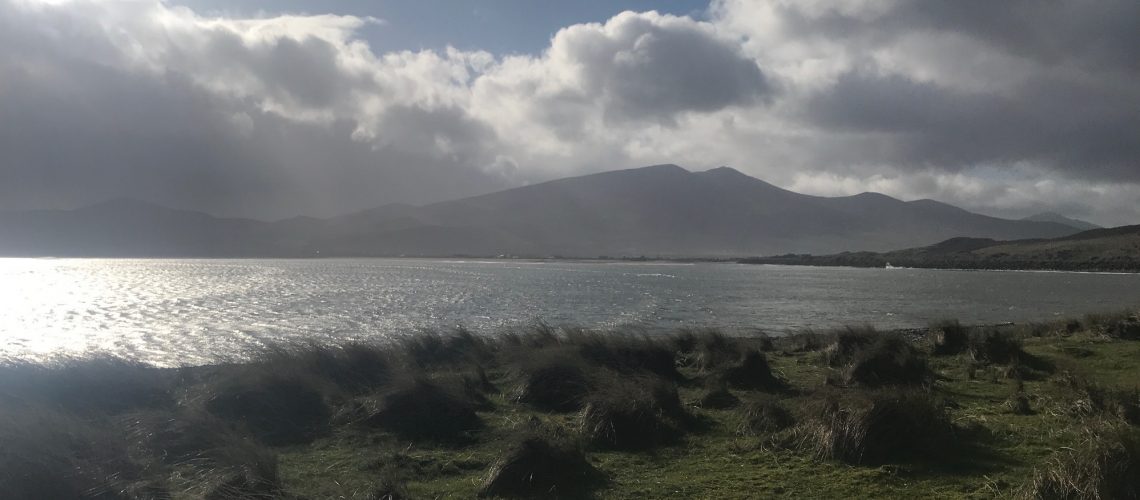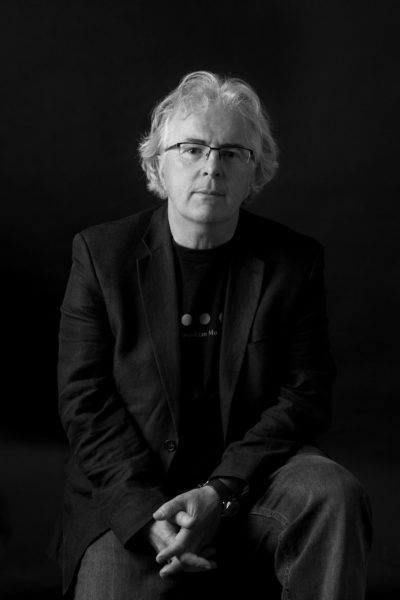Monday is walking day. Originally we’d hoped to be walking Friday, Saturday and Sunday too, but the best laid plans etc.
We decided on a loop around The Magharees (Na Macharaí, ‘the plains’) as described in Adrian Hendroff’s The Dingle Peninsula: a Walking Guide. It’s an excellent book, really well laid out and clear. The version we chose (he offers two) is about 16km, a three and a half hour walk.
We head off around 10:30, not early; it’s been raining heavily but due to ease off as the day goes on. We take in the views from the top of The Connor Pass down to Cloghane, the valley a dull dun colour, the lakes standing out, sheer in scattered sunlight. An Loch Dubh, An Loch Gheal, and Loch Uí Fhiannachta.
The peninsula where we’re headed seems unrealistically far in the distance, but that’s a trick of the light, or lack of it, as a rain shower scattered itself down, from Benoskee and Stradbally Mountain to our east.
We park in Castlegregory beach and suit and boot up. Our plan is to head north along the eastern side of the promontory and head around anti-clockwise. There’s a strong westerly blowing so we’re fairly sheltered for the first part of it, anyway.
The waves outside the opening of Tralee Bay are spectacular, pounding white surf off some reef and climbing up over one of the small scattered islands, of which there seem to be several. But those on the beach are placid enough.
Birds. Lots of birds, and our interest is piqued.
Hundreds of sea birds (mostly common gulls with their yellow beaks and black wing tips – a delicate gull, unlike the brutish herring gulls) are feeding on something at the very tip of the water, pecking away mad, hundreds of them, fierce busy, whatever’s offered itself to them. Oyster catchers, too, comical birds for some reason – Padraig thinks their colours and exaggerated beak makes them cartoonish. Plovers, those busy little things dancing in away from waves and back out after them.
In truth, there’s been a lot of bird activity, all morning. In the car park and the grass in front of the house there were starlings and some kind of thrush, mistle-thrush, I think from how erect they were. And pied wagtails flittering about by the car. And the clear squeaky wheelbarrow sound of a dunnock coming from some bushes when we left the house.
Then we drove under a great flock of lapwings, all white breasted and black winged, at the end of the Conor Pass – such a lift to see na pilibíní, so called because of their little wispy crests at the top of their heads – after King Philip II of Spain, who was often depicted wearing a hat with a curled feather. Through his marriage to Queen Mary I of England, he was ‘King of Ireland’ from 1554-58. Note the perverted commas. King of Ireland indeed! We saw a raptor on the way home, near Dingle, dark and purposeful, low by the ditch, its wingtips sharp as daggers.
Onward north we went, on the beach or on the tufty grass beside the beach. Flat at places, more undulating at others, the odd big dune. Strange topography, dry in places and then with large rainwater lakes, like tourloughs, but we couldn’t decide whether there was peat or some kind of stone under us. We found big lumps of peat on the beach, so there’s turf down there under the strand, but hard to imagine that’s all, with the sea battering the place on three sides 365 days a year, down the millennia. Dirty looking small wintery cattle behind fences, being fed on silage or hay. Heifers, mostly. A curious pale yellow kind of colour about them.
The light changing, constantly. The colours changing constantly: grey to dark to blue, white clouds surrounding the space. Light on the water, sunlight glinting on the long dune grass. The green of the short grass. The curve of glistening waves running to shore, from black to white.
The wind whining, the thump of waves, the ululation of a herring gull, the cough of rooks.
Showers came down at us from Brandon, which we couldn’t see, of course, shy under cloud as usual. Padraig reckoned it appeared one day in seven, which seemed portentous, somehow, I don’t know how or why. We took shelter the odd time under the small sandy cliffs, but none of the showers lasted long. We trooped on past Magherabeg, a small conurbation there and a very ugly surfing centre, with garishly yellow railway containers and I was reminded of William Flanagan again and his disdain for the mainstreaming and commercialisation of surfing.
Choughs, rooks, jackdaws and hooded crows, the corvids were about, God bless them, and I do love the red footed, red beaked chough and his cearc cearc sound – which is the Irish word if I’m not mistaken for a hen.
We heard the geese before we saw them, the unmistakable honking sound, deep in folklore. Brent geese, light-bellied, that white crescent on the black neck a giveaway, all the way down from Arctic Canada, no less, welcome immigrants, colourful and interesting. Maybe 20 here but a lot more further on and sure enough on the Birdwatch Ireland website, Tralee Bay is one of the sites where they’ve been noted, along with many other estuaries.
The sand up near Kilshanning was greyer and courser than the Castlegregory beach for some reason. A lot of houses there, higgledy piggledy just at the northern tips which looks like the antennae of a snail on the map. Across to the western side, face into the wind, and it’s wild here, great waves crashing up on the beach, with special purpose now, near high-tide.
The Slieve Mish Mountains, the dark clouds coursing over them. Sets of high ocean swells powering into the bay and onto the beach. The clouds letting the sunlight through on the low fields of the mountains, washing away the indistinct grey and splattering green shapes in the distance. A bank of herring gulls floating high against the gale along the line of the beach, watching out for some edible detritus to be washed ashore; a hundred million years of evolutionary intelligence in the way they can ride the wind without effort or thought.
Back home via the road, the legs straining now. And I love that moment when it begins to hurt. Not that I enjoy the hurt but it’s a reminder that you’re alive. As long as you can do it – I hate when I can’t do something – it’s great to be pushing your body out of the comfort into pain. I never minded pain, when I was playing sport, or training for games, it’s an interesting liminal place before the body can’t do any more, but driving it on, pounding on, for more.
Back to the beach at the eastern side, near where we started. That lovely feeling when high tide is in the red hour, in the evening. The closeness of the water, the intimacy of the waves, the calmness, the associated comfort of evening by the beach. The fresh sea air, the purpose of the waves lifting, assured – curving and breaking – then washing back out against another incoming wave.
Eternal.
The drive home, sated, ready for rest and food and the pub for the United Chelsea game. Which is going to be fucking epic.

